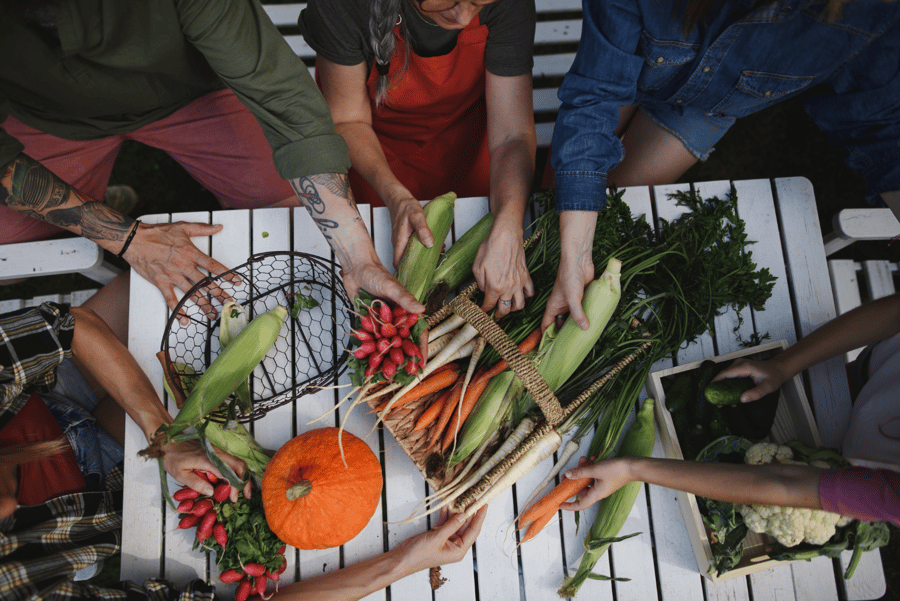Promoting Healthy Communities by Distributing Fresh Fruits and Veggies
November 3, 2022 Posted by Jesse M. Ehrenfeld, MD, MPH

To learn more about this funded project, click here.
Eating more fresh fruits and vegetables is good for all of us. These vitamin-packed natural foods help fight cancer, obesity, and heart disease.
But not everyone has access to the foods that they need to grow strong and healthy. There are particular barriers for low-income communities of color when it comes to accessing fresh food.
What are the systemic barriers to accessing healthy food? What are organizations doing to address the problem? And how does distributing healthy food to underserved populations help in promoting healthy communities?
A Systemic Problem
Wello is a nonprofit with a mission of “co-creating community conditions that are fair and just to drive high levels of health and well-being for all.”
With financial support from the Advancing a Healthier Wisconsin Endowment and in partnership with Principal Investigator Leslie Ruffalo, PhD, associate professor and co-director of Medical Student Education in the Department of Family and Community Medicine at the Medical College of Wisconsin, this organization is working to address racial and socioeconomic disparities in the Green Bay area, including a number of projects that address food security and food sovereignty.
In its 2021 Community Health and Well-Being Survey, Wello collected data on Brown County residents, attempting to capture their thoughts on their physical and psychological health, including social environments. This survey attempts to capture not just the biological markers of a healthy community, but what are called the social determinants of health.
Social determinants have been found to have a deep impact on health. These can include factors like
-
Race
-
Economic status
-
Education level
-
Access to safe housing and transportation
They also include less tangible factors like a sense of purpose and belonging.
Basically, trying to capture the social determinants of health is a holistic way of looking at what makes a healthy community.
White people with higher formal education levels and incomes reported more physical and psychological well-being than people of different races with lower incomes and less formal education. They also report more satisfaction with their social relationships and environments.
Some other findings from this key survey include the following:
-
The pandemic contributed to the decline of socio-psychological health. More people feel nervous, depressed, and isolated, and many people are getting poor sleep.
-
Disparities in socio-psychological health are increasing. Poor health is more common among women.
-
Fewer people are feeling optimistic about the future, and women are particularly concerned.
-
And here is one hopeful change: More people are taking a walk every day or almost every day.
We all know that healthy eating is a key component of wellness. So how does that fit into the picture?
Removing Barriers to Fresh Food
As part of its mission to improve wellness in the greater Green Bay area, Wello has embarked on a project that coordinates multiple partners in an effort to address equity and logistical challenges involved in getting healthy foods into the hands of low-income people of color. They looked at two places where low-income and food insecure people can get food: farmers markets and food pantries. They identified some issues with each.
Food pantries don’t always have high-quality fresh produce, and often people have to prove that they are low-income to use pantries. This can be a problem, especially among marginalized populations or undocumented immigrants who are fearful or distrustful of having to register or prove their residency.
Farmers markets have an abundance of fresh produce, and programs like the SNAP program’s market bucks help people receiving food assistance to purchase food at markets. But again, undocumented populations are excluded from SNAP. Additional transportation, language, or logistical barriers keep some low-income people of color from feeling like they are welcome at markets.
Wello’s solution is to utilize trusted Community Resource Centers to become distribution centers for produce boxes that contain high-quality, fresh fruits and vegetables sourced from local farmers. They also educate people about the availability of economic incentives (called Double Your Bucks) that encourage people to shop at markets.
Working with Trusted Organizations
Part of the promise of this community-based wellness program is the strong partnerships between Wello and trusted community organizations that serve low-income people of color. Wello is building on a foundation of a project launched to distribute fresh food during COVID-19.
What Wello learned during this effort was that staff at these organizations know the people they serve and are better at helping people avoid slipping through the cracks of bureaucratic government systems. When the food security organizations, farmers, and community service organizations all come together at the same table, the results are a more just food distribution system rooted in equity.
Wello’s collaborators are:
-
We All Rise African American Resource Center (AARC)
-
Casa ALBA Melanie (CAM)
-
Crusaders de Justicia (CDJ)
-
Seasonal Harvest (SH)
-
UW-Madison Division of Extension Brown County
-
Jacob Dyer, of the Medical College of Wisconsin’s School of Pharmacy
Healthy Food in Safe Spaces
Wello isn’t aiming to replace pantries and markets with the produce boxes distributed at community organizations. They also want to educate people on the benefits of shopping at markets and accessing pantries. The produce boxes include $10 in Double Your Bucks market incentives that people can redeem at farmers markets.
However, because of the barriers mentioned earlier, it’s still important to distribute healthy food in “trusted resource centers,” where low-income people of color already visit. Low-income and undocumented folks will not experience the stigma of using “market bucks” that identify them as SNAP recipients, and they will not have to prove their residence or income.
Creative Solutions to Improve Community Health
Eating more fresh fruits and vegetables can help improve our health. Plant-based diets have been shown to improve heart health and fight cancer and obesity.
But until more systemic barriers to healthy food are removed, low-income people of color are still challenged to obtain the foods that can help them live healthier lives.
That’s why community health projects like Wello’s are such an inspiration. This collaboration is marshaling community resources to ensure that more people can open up a delicious box of fresh Wisconsin-grown produce and make a healthy meal.



.png?width=300&name=Caregiver%20Roundup%20Blog%20Featured%20Image%20(2).png)
